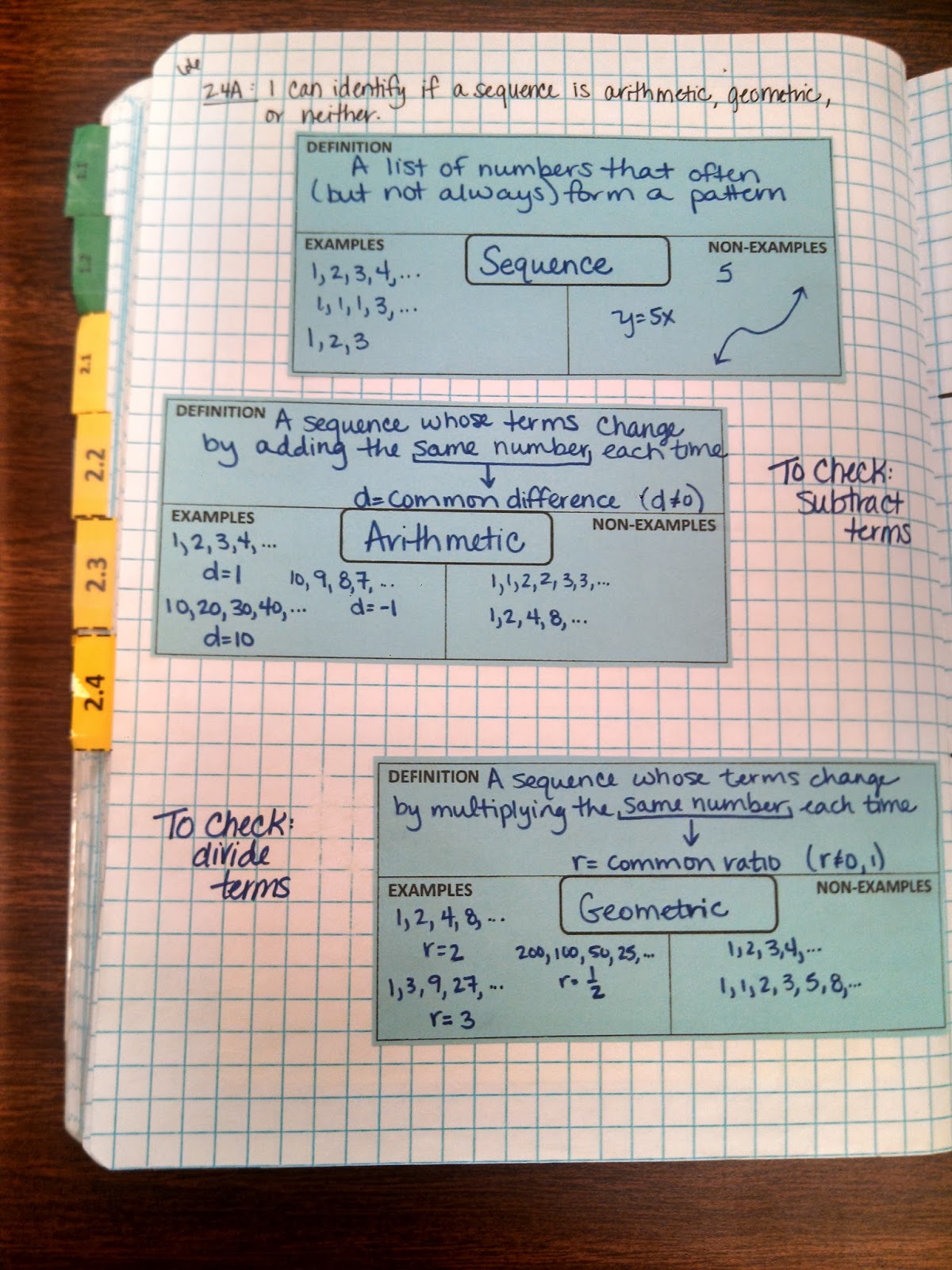Before we even do anything officially sequence related, I usually give my students four sequences (one adding, one subtracting, one multiplying, and one dividing). I give the first four terms and ask them to find the pattern, the starting point, and the next three terms. This gives them a little time to transition to new material that appears easy.
This time we tried a table of contents. (Which I got from Sarah at math=love. You can find it here.) I liked it a lot because I used it to makes students think (just a little) about what was on each page.
 |
| Table of Contents |
 |
| Definitions |
 |
| Sort these |
Next we discussed writing formulas for the sequences. Since I had asked about starting point and pattern as we went, I thought recursive was a natural follow. Instead of using all the nasty notation (a_n, a_1, etc.), I talked with my area education association and someone recommended this now = /next = notation.
Note: I liked it a lot, but students wanted to just put the "now" in for the "now" in the second equation so that there would only be one equation. I think it might have been better to use start = /next = now/. That might help.
To practice I displayed a bunch of sequences and asked students to write the recursive formula for 8 of the 12.
 |
| Practice Problems to be displayed |
 |
| My notebook had the answers :) |
Next we looked at writing formulas explicitly. I tied this into the equations for linear and exponential functions. We did a mini-breakdown of the equations in class and came up with:
- Arithmetic: a = d*n + start
- Geometric: a = start*r^n
Those would be very familiar to them and still used a little bit of "sequence notation".
 |
| Notes on explicit formulas |
We practiced writing explicit formulas the same way we did recursive (even with the same exact sequences).
 |
| My notebook :) |
My last learning target for this unit is "I can explain why a sequence is a function." It is perhaps a not-so-great learning target because it is somewhat difficult to teach and assess in a way that requires student thinking and learning. However, it is very closely aligned to a standard (F.IF.3...?) and I struggle with the battle between whether I should be assessing standards or learning targets. Anyway those thoughts are best left for a different post.
Here is what we did. It was an investigation of sorts, where students were to choose a sequence and determine if the table that represented it was a function and if the graph that represented it was a function. However we had difficulties because my students didn't do super well with determining if something is a function.
The goal was that students would choose a wide-variety of functions and we could whiteboard individual results, do a gallery walk, and come to the conclusion that all sequences were functions. However it didn't go down quite like that. I perhaps needed another day of class, but it was crunch time for semester tests, so I didn't have any wiggle room.
I ended up having a class discussion, but not assessing that standard. It is what it is I suppose.
 |
| Sequence = Function (p.1) |
 |
| Sequence = Function (p. 2) |
- I wish I had done more vocabulary up front (ie. term, first term, second term, common difference, common ratio). It is hard for me to remember what words are new to students.
- Also a graphic organizer to show the relationship between sequence, arithmetic, and geometric.
- As I said, with recursive formula, I would change the first equation from now = ___ to start = ___.
- I've really been thinking about how I need to spiral some review in for students. (More on this later...probably not until this summer.) I believe this would have helped as we looked at sequences as functions.
Please leave any thoughts or suggestions in the comments, or tweet me (@kathrynfreed).
-Kathryn


It's cool that you did sequences after functions, and it sounds like it went well! I went the opposite route this year and I think that one thing I'll miss out on is the connection of exp fcts to geometric sequences. I'll have to review them a bunch when we get to exponentials (I'm doing them last). But I guess that's ok, spiraling sequences back in.
ReplyDeleteHave y'all done many visual patterns? We do one everyday now as a warm up. They crush the linear ones at this point. Trying a quadratic on Tuesday for the first time, we'll see how it goes.
I think you will have a good enough time tying in sequences to functions. Sequences are something that students grasp fairly easily. Did you use algebraic sequence notation? (Just curious.)
ReplyDeleteI haven't done much with visual patterns. We did some with linear functions when we were practicing writing equations, but it would be a good thing to bring into my bellwork here and there. Thanks for the reminder! I'd love to hear how the do with the quadratic on Tuesday!
This comment has been removed by the author.
ReplyDelete